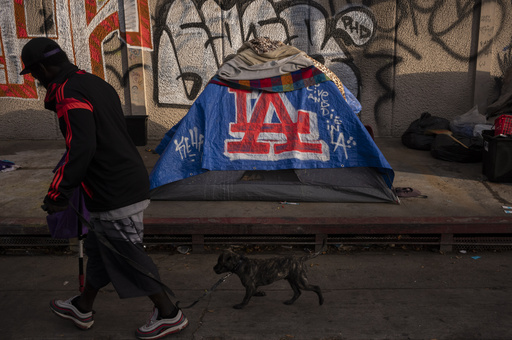The United States has experienced a significant 18.1% rise in homelessness this year, primarily attributed to the shortage of affordable housing, devastating natural disasters, and an influx of migrants across various regions, according to federal officials.
The Department of Housing and Urban Development (HUD) reported that surveys conducted in January revealed over 770,000 individuals had no permanent residence. This figure is likely an undercount, as it does not encompass those temporarily living with family or friends.
This current increase follows a previous 12% uptick in 2023, attributed to rising rents along with the expiration of pandemic-related assistance programs. Many of those experiencing homelessness this year are doing so for the first time. Overall, approximately 23 out of every 10,000 people in the U.S. are categorized as homeless, with Black individuals disproportionally represented in the homeless community.
“No American should face homelessness, and the Biden-Harris administration is dedicated to ensuring every family has access to safe, quality, and affordable housing,” stated Adrianne Todman, head of HUD. She emphasized the importance of evidence-based strategies to tackle and prevent homelessness.
One of the more alarming trends noted is the nearly 40% increase in family homelessness, particularly in urban areas impacted by a surge of migrants. Family homelessness has more than doubled in 13 specific communities, including major cities such as Denver, Chicago, and New York City, while it saw less than an 8% rise in the remaining 373 communities surveyed. On a single night in 2024, nearly 150,000 children faced homelessness, marking a 33% increase from the previous year.
Additionally, natural disasters, such as the catastrophic wildfire in Maui last year—the deadliest wildfire in the U.S. in over a century—have contributed to the homelessness numbers. During the survey night, over 5,200 individuals in Hawaii were found to be residing in emergency shelters.
The increasing rates of homelessness are a “tragic, yet expected result of underfunding essential resources and protections that are critical for securing and maintaining safe, affordable housing,” stated Renee Willis, the incoming interim CEO of the National Low Income Housing Coalition. “As researchers, advocates, and those with personal experiences have warned, homelessness continues to grow as housing costs remain exorbitantly high.”
Robert Marbut Jr., who previously served as the executive director of the U.S. Interagency Council on Homelessness, described the nearly 33% spike in homelessness over the past four years as “disgraceful,” urging the federal government to shift its focus away from prioritizing permanent housing. He advocates for more attention to be paid to treating issues like substance abuse and mental health as well as reinstating program requirements for job training.
The statistics are emerging amidst a growing movement in various communities, particularly in Western states, to adopt strict measures against homelessness. Many areas are enforcing bans on camping, responding to public pressure over the perceived dangerous and unsanitary conditions some individuals face. Earlier this year, the Supreme Court upheld that outdoor sleeping bans do not infringe upon the Eighth Amendment. Advocates for the homeless contend that penalizing those in need of shelter only criminalizes homelessness further.
However, there has been some encouraging news, as veteran homelessness has seen a downward trend. In 2024, the number of homeless veterans fell by 8% to 32,882, with an 11% decrease in unsheltered veterans, dropping to 13,851 individuals.
Ann Oliva, CEO of the National Alliance to End Homelessness, pointed out that this reduction in veteran homelessness provides a viable model for addressing the larger issue of homelessness nationwide. “With bipartisan support, appropriate funding, and effective policy interventions, we can mirror this success and work towards diminishing homelessness throughout the country. Federal investment is crucial in tackling the housing affordability crisis and providing safe, stable housing for all Americans,” she noted in her statements.
Some major cities have recorded success in reducing their homelessness figures. For instance, Dallas saw a 16% drop in homelessness rates from 2022 to 2024 after implementing reforms in its homeless system. Los Angeles reported a 5% decrease in unsheltered homelessness since 2023, as the city increased housing provisions. Notably, California retains the largest homeless population in the U.S., followed by New York, Washington, Florida, and Massachusetts.
The notable increase in the homeless population over the past couple of years stands in stark contrast to a prior trend of steady declines over the past decade. Between 2010 and 2017, efforts focused on securing housing for veterans saw a reduction in homelessness from approximately 637,000 to about 554,000.
However, this progress has reversed since the count from 2020, which showed about 580,000 homeless individuals. Numbers remained relatively stable over the next two years, thanks to federal emergency rental assistance and stimulus programs enacted during the COVID-19 pandemic, along with aid directed to state and local governments.



